Dollar Tree Bundle
How Did Dollar Tree Conquer the Discount Retail World?
Dollar Tree's story is a compelling narrative of entrepreneurial vision and strategic adaptation within the ever-evolving retail landscape. From its humble beginnings in the late 1980s, the Dollar Tree SWOT Analysis reveals a fascinating journey of growth and transformation. This discount retail giant, initially conceived around a simple yet powerful concept, has reshaped how consumers shop for everyday essentials.
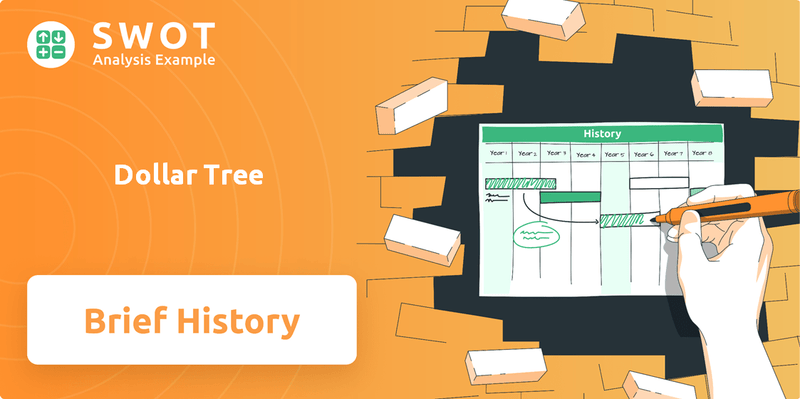
Delving into the Dollar Tree history reveals its origins as 'Only $1.00' in Norfolk, Virginia, spearheaded by Dollar Tree founder Macon F. Brock, Jr. Examining the Dollar Tree timeline, we see a company that has strategically expanded its Dollar Tree stores, adapting to market dynamics while staying true to its core value proposition. Understanding the Dollar Tree company's early years provides valuable insights into its enduring success.
What is the Dollar Tree Founding Story?
The Dollar Tree history began in 1986. Macon F. Brock, Jr., Doug Henderson, and J. Douglas Perry founded the company, initially named 'Only $1.00'. Their vision was to offer a straightforward shopping experience with everything priced at a dollar, providing clear value to customers.
The Dollar Tree company started with a simple business model: source a wide variety of goods at low costs and sell them all for a dollar. This approach quickly resonated with consumers. The first store opened in Norfolk, Virginia, marking the beginning of what would become a major player in the discount retail market. The Dollar Tree origin story is rooted in the founders' commitment to value and simplicity.
The initial store, 'Only $1.00,' opened in 1986 in Norfolk, Virginia. The founders used their personal capital to fund the venture, focusing on a simple, value-driven business model.
- The name 'Only $1.00' directly communicated the core value proposition to consumers.
- The mid-1980s economic climate, with a growing demand for discount shopping, provided a favorable environment for growth.
- The founders' expertise in retail operations and merchandising was essential for navigating the early challenges.
- The initial product range included household essentials, party supplies, toys, and seasonal decorations.
The early success of the Dollar Tree stores was driven by its clear value proposition and the founders' understanding of retail. The company's focus on a fixed price point simplified the shopping experience, attracting a broad customer base. The Dollar Tree founder, Macon F. Brock, Jr., leveraged his retail background to establish a sustainable business model. The company's Dollar Tree timeline shows a consistent growth trajectory.
The company's initial concept of selling everything for a dollar was a key differentiator. The founders' ability to source products at low costs and maintain a consistent price point was crucial. The early years of the company were marked by careful management and strategic decisions. For more insights into the company's financial structure, consider exploring the Revenue Streams & Business Model of Dollar Tree.
Dollar Tree SWOT Analysis
- Complete SWOT Breakdown
- Fully Customizable
- Editable in Excel & Word
- Professional Formatting
- Investor-Ready Format
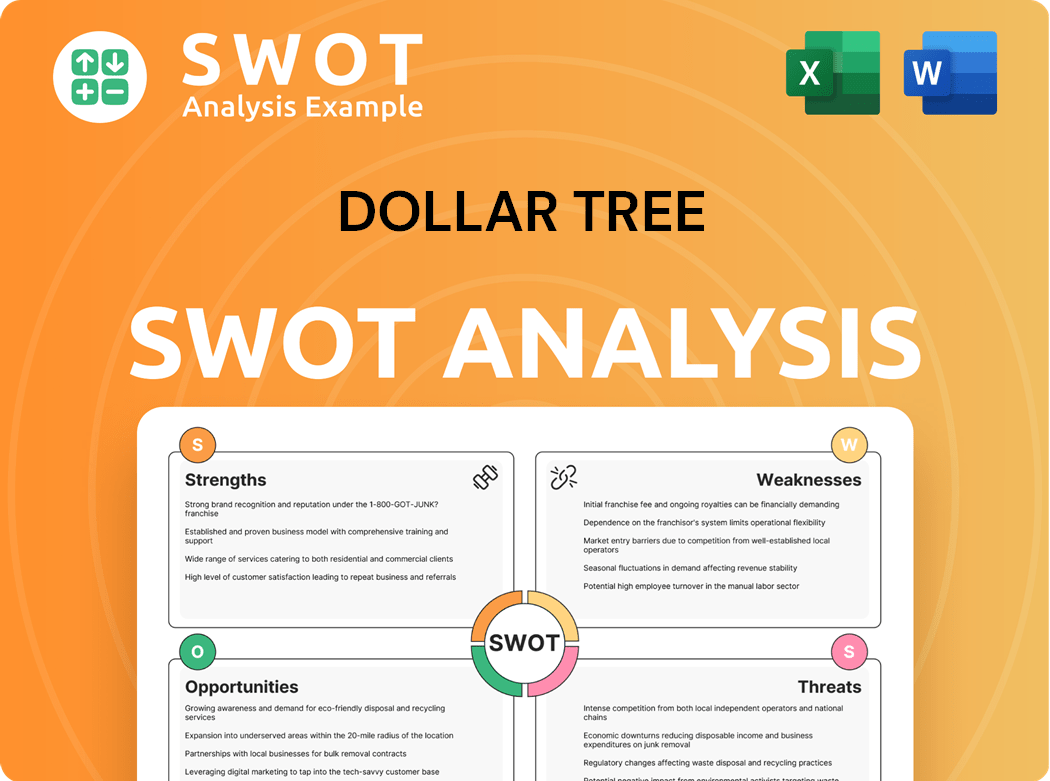
What Drove the Early Growth of Dollar Tree?
The early growth and expansion of the Dollar Tree company, a key part of the Dollar Tree history, centered on rapidly increasing its store count and diversifying its product offerings. Starting in 1986 as 'Only $1.00,' the company quickly focused on opening more locations, primarily in shopping centers. This expansion laid the groundwork for what would become a major player in the discount retail sector. Understanding the Dollar Tree origin is crucial to appreciating its current market position.
The company, founded by Dollar Tree founder, initially operated under the name 'Only $1.00.' By 1991, it rebranded to Dollar Tree, Inc., signaling a broader vision. This change reflected the company's ambition to expand beyond a single price point, even though the $1.00 price remained central. This early Dollar Tree timeline shows a clear strategic shift towards growth.
The early 1990s marked significant store expansion for Dollar Tree stores, reaching 100 stores by 1993. This rapid growth was fueled by strong consumer acceptance of its value proposition. Key strategies included refining its merchandising to include everyday essentials and seasonal items. Centralizing its distribution network was also crucial for operational efficiency.
A major milestone was the initial public offering (IPO) in 1995, which provided capital for further expansion. This allowed Dollar Tree to accelerate store openings and explore new markets. By the late 1990s, Dollar Tree had established a strong presence across the Eastern United States. A detailed look at the Growth Strategy of Dollar Tree reveals the company's strategic moves during this period.
The company's strategic decision to maintain a consistent low price point, even as other retailers experimented with varied pricing, contributed to its distinct market position and customer loyalty. Leadership transitions during this period focused on professionalizing operations and scaling the business. This focus helped shape how Dollar Tree changed the discount market.
Dollar Tree PESTLE Analysis
- Covers All 6 PESTLE Categories
- No Research Needed – Save Hours of Work
- Built by Experts, Trusted by Consultants
- Instant Download, Ready to Use
- 100% Editable, Fully Customizable
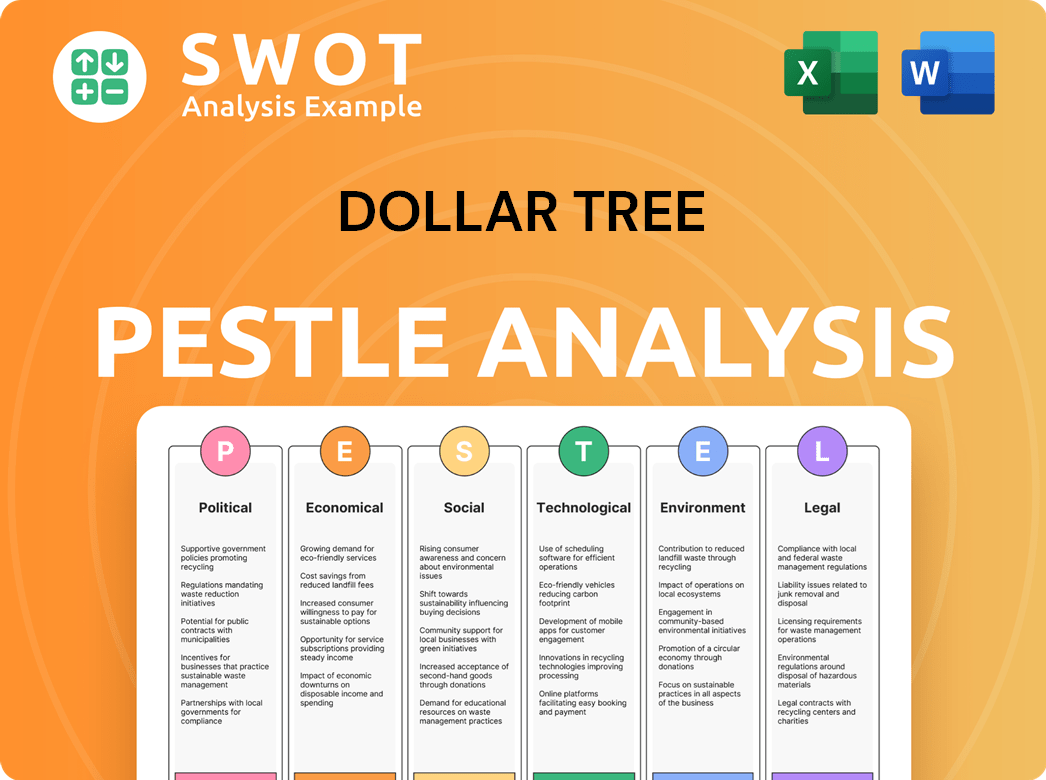
What are the key Milestones in Dollar Tree history?
The Dollar Tree history is marked by significant milestones that have shaped its growth and market position. From its humble beginnings to becoming a major player in the discount retail sector, the company has consistently adapted to market changes and consumer demands. The Dollar Tree company has expanded its footprint and offerings while navigating economic fluctuations and competitive pressures.
| Year | Milestone |
|---|---|
| 1986 | Dollar Tree's origin began with the opening of its first store. |
| 1995 | The company went public, providing capital for expansion. |
| 2015 | Dollar Tree acquired Family Dollar, significantly increasing its store count. |
| 2022 | The company implemented a price increase, adjusting its base price to $1.25. |
| 2024 | The company plans to renovate 1,000 Family Dollar stores. |
A key innovation in the Dollar Tree company was its consistent $1.00 price point, which simplified operations and created a strong brand identity. This strategy resonated with consumers seeking value, making the company a popular choice for budget-conscious shoppers.
For many years, the company maintained a $1.00 price point, which was a cornerstone of its business model. This simplified inventory management and marketing, creating a clear brand identity.
The company expanded its product offerings to include a wide variety of items, from household goods and party supplies to food and personal care products. This diversification helped attract a broader customer base.
The acquisition of Family Dollar in 2015 was a significant strategic move. This expanded the company's market share and provided access to a different customer segment.
Dollar Tree has continuously worked on optimizing its supply chain to manage costs and ensure product availability. This includes efficient distribution and inventory management practices.
The company has adapted its store formats to meet the needs of different markets and customer preferences. This includes variations in store size and product assortment.
The company has integrated technology to improve operations and enhance the customer experience. This includes the use of data analytics for inventory management and targeted marketing.
The Dollar Tree stores have faced several challenges, including economic downturns and rising costs, particularly in the 2020s. Maintaining profitability while keeping prices low has been a constant balancing act. The integration of Family Dollar has also presented complexities in terms of operations and brand alignment.
Rising costs of goods have consistently challenged the company's ability to maintain its $1.00 price point. This has led to strategic price adjustments.
Disruptions in the supply chain have impacted the availability of products and increased costs. Efficient supply chain management is crucial for maintaining profitability.
Integrating Family Dollar's operations and culture has presented challenges. The company continues to optimize the performance of Family Dollar stores.
The discount retail market is highly competitive. The company faces competition from other dollar stores and big-box retailers.
Adapting to changing consumer preferences and shopping habits is essential. The company must stay relevant in a dynamic retail environment.
Managing labor costs and ensuring adequate staffing levels are ongoing challenges. The company must balance labor expenses with the need for efficient operations.
Dollar Tree Business Model Canvas
- Complete 9-Block Business Model Canvas
- Effortlessly Communicate Your Business Strategy
- Investor-Ready BMC Format
- 100% Editable and Customizable
- Clear and Structured Layout
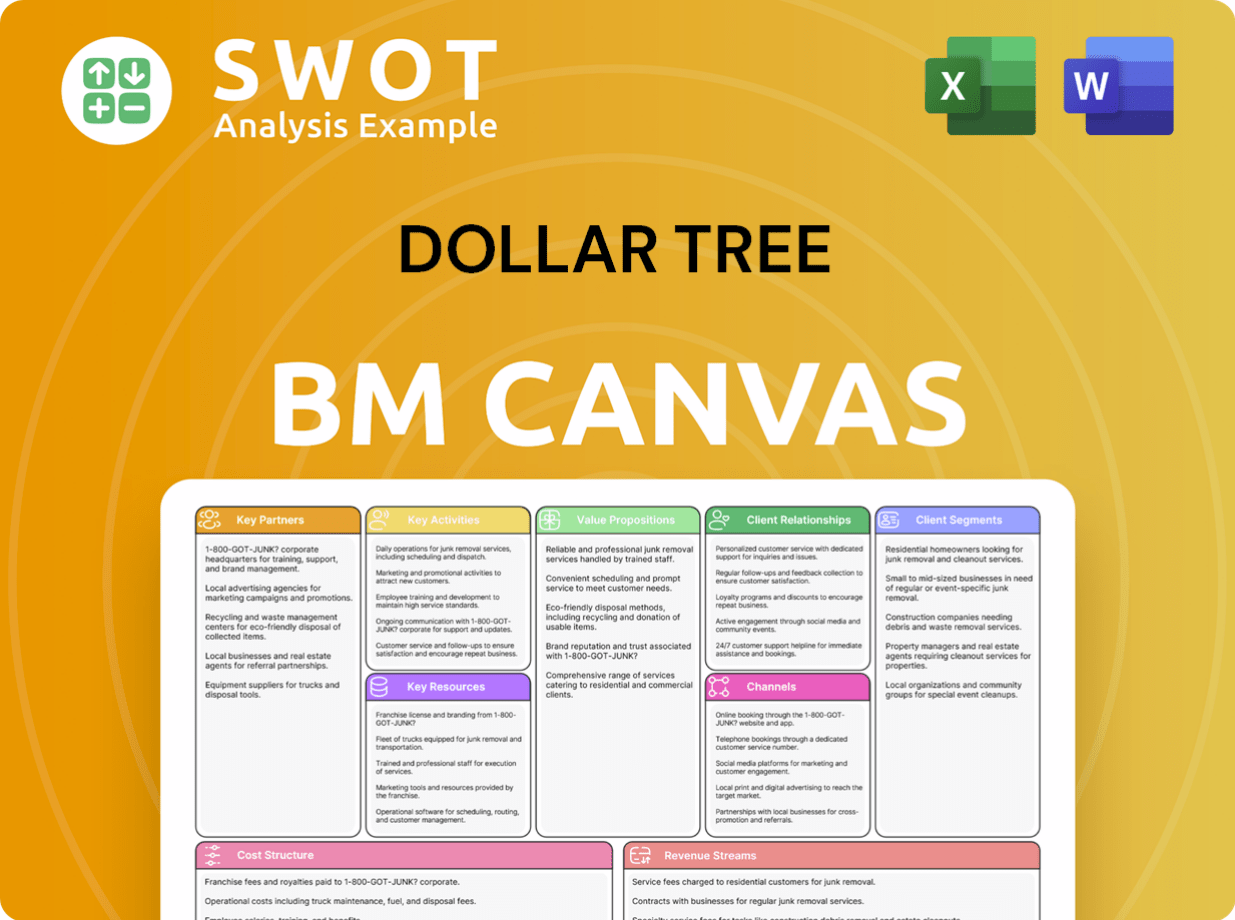
What is the Timeline of Key Events for Dollar Tree?
The Dollar Tree company's history is marked by strategic growth and adaptation within the discount retail sector. From its humble beginnings to its current status, the Dollar Tree has consistently evolved, adapting to market changes and consumer preferences. The Dollar Tree founder's vision laid the groundwork for a business model focused on value and affordability, which has been a cornerstone of its success. The following Dollar Tree timeline highlights key milestones in its journey.
| Year | Key Event |
|---|---|
| 1986 | Founded as 'Only $1.00' in Norfolk, Virginia, marking the Dollar Tree origin. |
| 1991 | Rebranded as Dollar Tree, Inc., signaling a new phase in its identity. |
| 1993 | Reached 100 stores, demonstrating early expansion success. |
| 1995 | Completed its Initial Public Offering (IPO), entering the public market. |
| 1996 | Acquired 136-store Dollar Bills, Inc., accelerating its growth trajectory. |
| 1997 | Opened its first distribution center in Chesapeake, Virginia, improving logistics. |
| 2000 | Opened its 1,500th store, showcasing significant expansion. |
| 2003 | Launched its e-commerce platform, DollarTree.com, expanding its reach. |
| 2008 | Opened its 3,500th store, continuing its rapid growth. |
| 2012 | Opened its 4,500th store, reflecting sustained expansion efforts. |
| 2015 | Acquired Family Dollar Stores, Inc., significantly increasing its market presence. |
| 2021 | Announced a plan to raise base prices from $1.00 to $1.25 on most items, adapting to economic changes. |
| 2022 | Implemented the $1.25 price point across most stores, reflecting a strategic shift. |
| 2024 | Continues to focus on optimizing the Family Dollar brand, with plans to renovate 1,000 Family Dollar stores. |
Dollar Tree is refining its multi-price point strategy, especially within Family Dollar stores, to better meet diverse consumer needs. The 'Dollar Tree Plus' concept, offering items at higher price points ($3 and $5), allows for a broader merchandise assortment and increased sales per square foot. These initiatives aim to adapt to inflationary pressures and enhance profitability.
The company plans to open 600 new stores in fiscal year 2024, consisting of 400 Dollar Tree and 200 Family Dollar stores. This aggressive expansion strategy underscores the company's commitment to growth. This expansion will help the company to increase its market share.
The company is focusing on supply chain efficiencies and inventory management to improve operational performance. Store optimization is also a key priority. These operational improvements are designed to drive shareholder value through enhanced efficiency and strategic growth. You can find more information about Dollar Tree's competitors in the Competitors Landscape of Dollar Tree.
The company aims to evolve its value proposition while staying true to its founding vision of providing affordable products to a broad customer base. This commitment to affordability and value positions Dollar Tree for continued relevance in the retail market. The company's strategic initiatives are focused on maintaining its competitive edge.
Dollar Tree Porter's Five Forces Analysis
- Covers All 5 Competitive Forces in Detail
- Structured for Consultants, Students, and Founders
- 100% Editable in Microsoft Word & Excel
- Instant Digital Download – Use Immediately
- Compatible with Mac & PC – Fully Unlocked
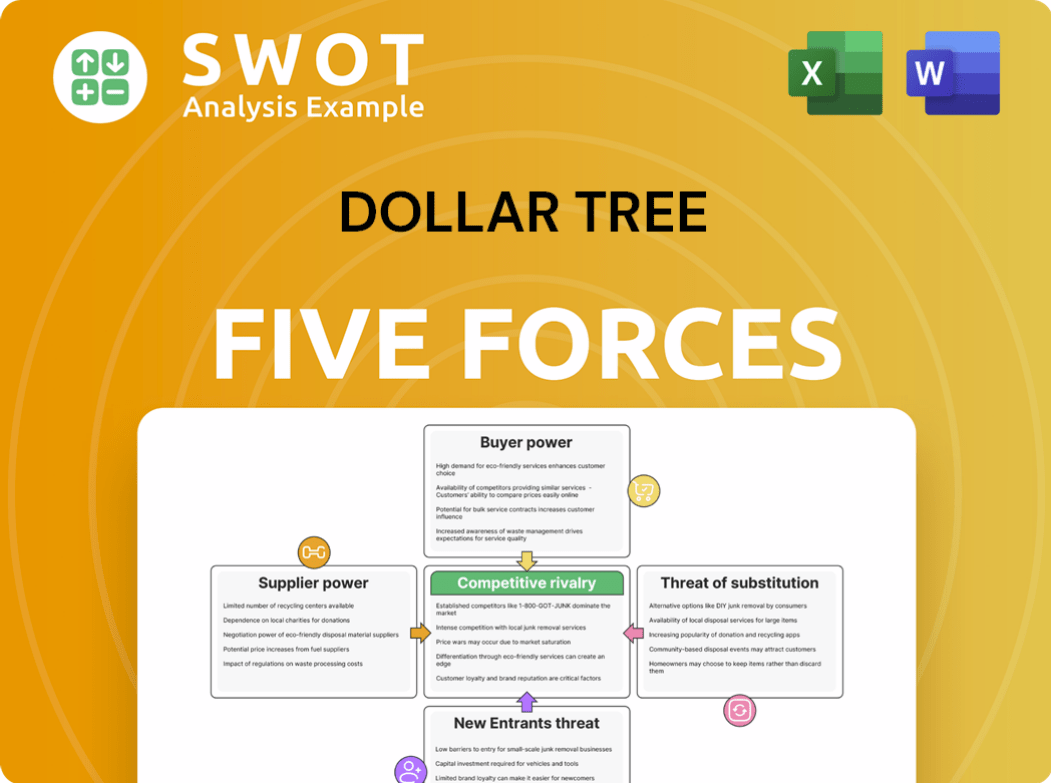
Related Blogs
- What is Competitive Landscape of Dollar Tree Company?
- What is Growth Strategy and Future Prospects of Dollar Tree Company?
- How Does Dollar Tree Company Work?
- What is Sales and Marketing Strategy of Dollar Tree Company?
- What is Brief History of Dollar Tree Company?
- Who Owns Dollar Tree Company?
- What is Customer Demographics and Target Market of Dollar Tree Company?
Disclaimer
All information, articles, and product details provided on this website are for general informational and educational purposes only. We do not claim any ownership over, nor do we intend to infringe upon, any trademarks, copyrights, logos, brand names, or other intellectual property mentioned or depicted on this site. Such intellectual property remains the property of its respective owners, and any references here are made solely for identification or informational purposes, without implying any affiliation, endorsement, or partnership.
We make no representations or warranties, express or implied, regarding the accuracy, completeness, or suitability of any content or products presented. Nothing on this website should be construed as legal, tax, investment, financial, medical, or other professional advice. In addition, no part of this site—including articles or product references—constitutes a solicitation, recommendation, endorsement, advertisement, or offer to buy or sell any securities, franchises, or other financial instruments, particularly in jurisdictions where such activity would be unlawful.
All content is of a general nature and may not address the specific circumstances of any individual or entity. It is not a substitute for professional advice or services. Any actions you take based on the information provided here are strictly at your own risk. You accept full responsibility for any decisions or outcomes arising from your use of this website and agree to release us from any liability in connection with your use of, or reliance upon, the content or products found herein.